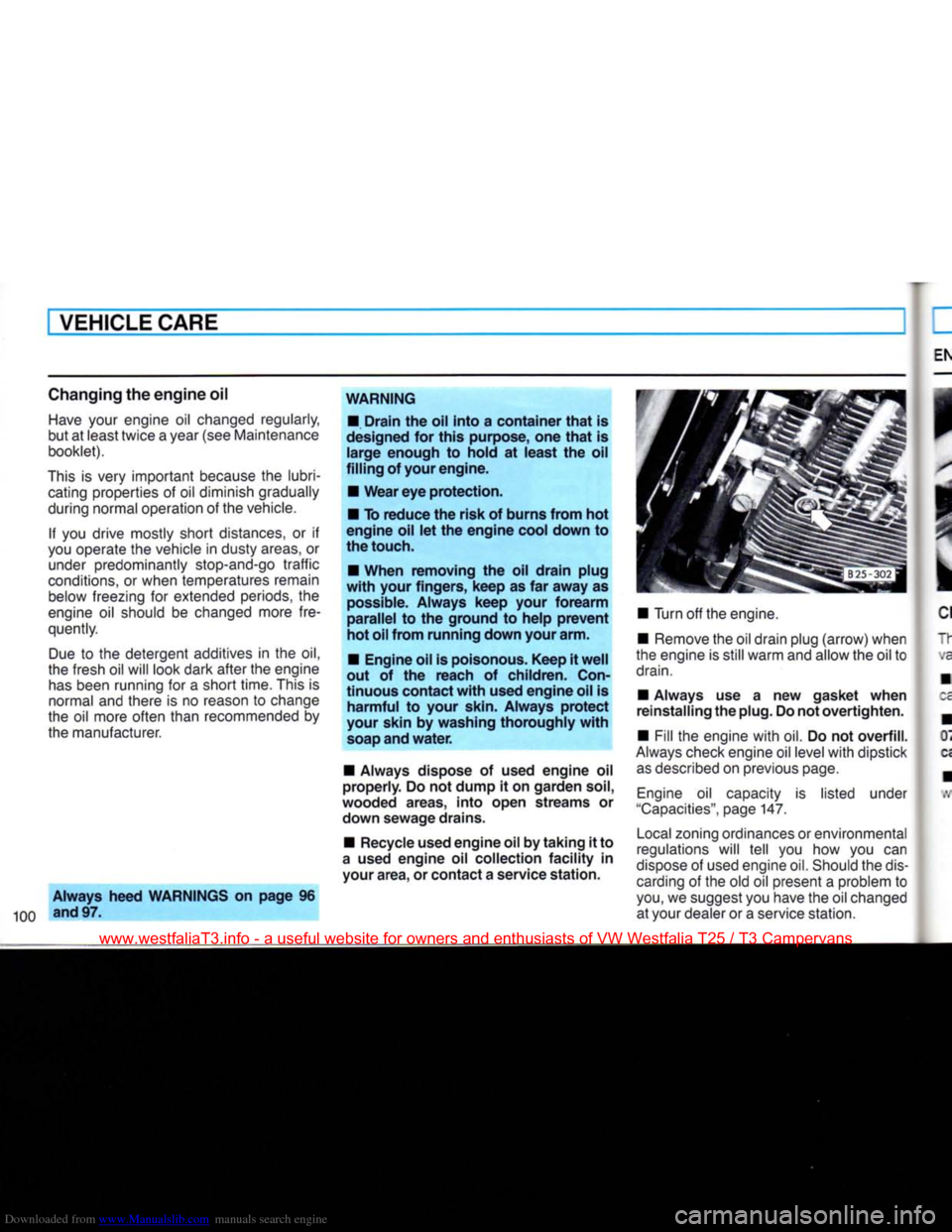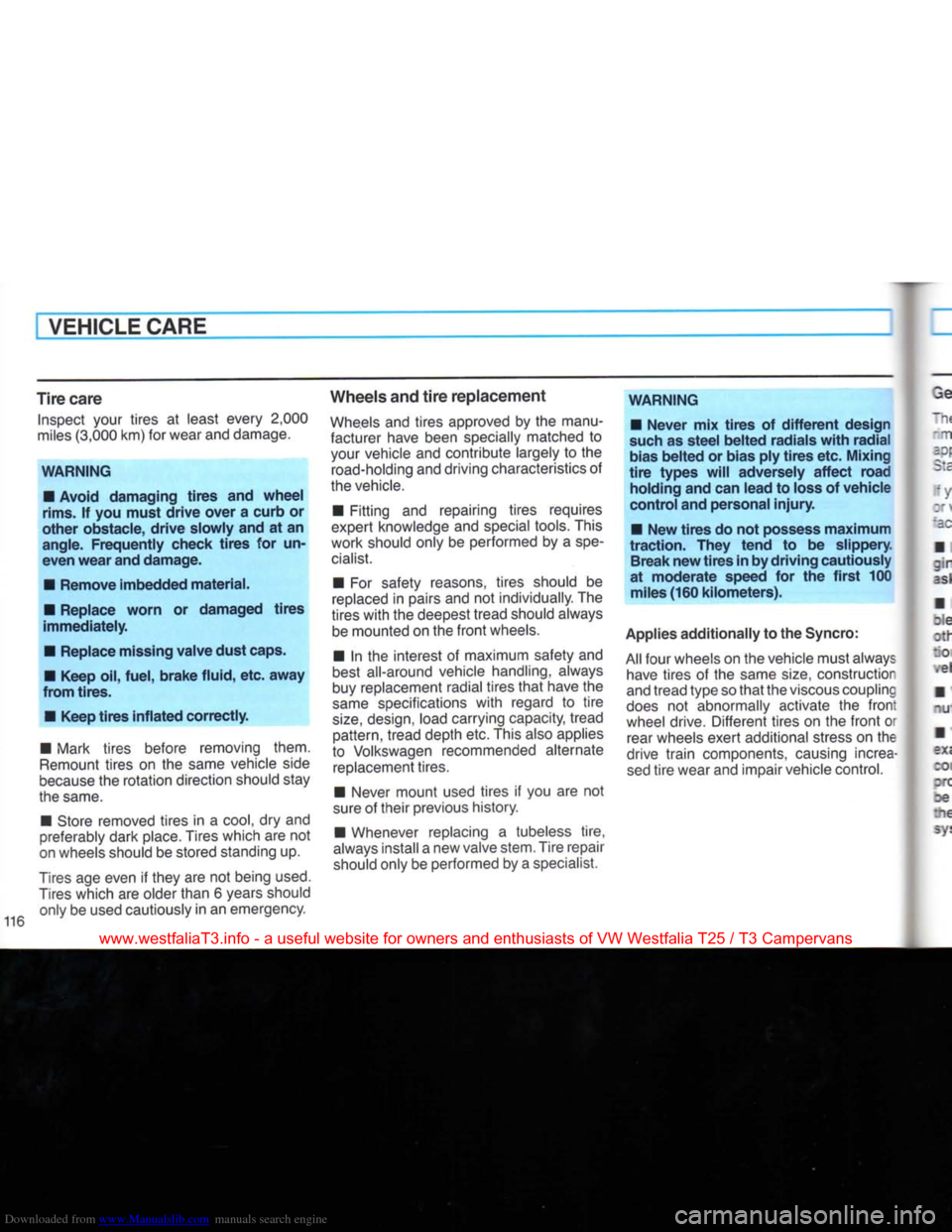1990 VOLKSWAGEN TRANSPORTER oil capacity
[x] Cancel search: oil capacityPage 105 of 165

Downloaded from www.Manualslib.com manuals search engine
VEHICLE CARE
Changing the
engine
oil
Have
your engine oil changed regularly,
but at least twice a year (see Maintenance
booklet).
This
is very important because the lubri cating properties of oil diminish gradually
during normal operation of the vehicle.
If you drive mostly short distances, or if
you operate the vehicle in dusty
areas,
or under predominantly stop-and-go traffic
conditions, or when temperatures remain below freezing for extended periods, the
engine oil should be changed more fre
quently.
Due
to the detergent additives in the oil,
the fresh oil will look dark after the engine
has
been running for a short time. This is
normal and there is no reason to change
the oil more often than recommended by
the manufacturer.
Always
heed
WARNINGS
on
page
96
100 and97-
WARNING
•
Drain
the oil
into
a
container
that
is
designed for
this
purpose, one
that
is
large
enough to hold at
least
the oil
filling
of your
engine.
•
Wear
eye
protection.
• To
reduce
the
risk
of burns
from
hot
engine
oil let the
engine
cool
down
to
the touch.
•
When
removing
the oil
drain
plug
with
your fingers,
keep
as far
away
as possible.
Always
keep
your
forearm
parallel
to the ground to
help
prevent
hot oil
from
running
down
your arm.
• Engine oil is poisonous. Keep it
well
out of the
reach
of children. Con
tinuous
contact
with
used
engine
oil is
harmful
to your skin.
Always
protect
your skin by
washing
thoroughly
with
soap and
water.
•
Always
dispose of used
engine
oil
properly.
Do not
dump
it on
garden
soil,
wooded
areas,
into
open
streams
or
down
sewage
drains.
• Recycle used
engine
oil by
taking
it to
a used
engine
oil collection
facility
in
your
area,
or
contact
a service
station.
• Turn off the engine.
• Remove the oil drain plug (arrow) when
the engine is still warm and allow the oil to
drain.
•
Always
use a new
gasket
when
reinstalling
the plug. Do not
overtighten.
•
Fill
the engine
with
oil. Do not
overfill.
Always
check engine oil level
with
dipstick
as
described on previous page.
Engine
oil capacity is listed under
"Capacities",
page 147.
Local
zoning ordinances or environmental
regulations will tell you how you can
dispose
of used engine oil. Should the dis carding of the old oil present a problem to
you,
we suggest you have the oil changed
at your dealer or a service station.
www.westfaliaT3.info - a useful website for owners and enthusiasts of VW Westfalia T25 / T3 Campervans
Page 121 of 165

Downloaded from www.Manualslib.com manuals search engine
VEHICLE CARE
Tire
care
Inspect your tires at least every 2,000
miles (3,000 km) for wear and damage.
WARNING
• Avoid
damaging
tires
and
wheel
rims.
If you
must
drive
over
a
curb
or
other
obstacle,
drive
slowly
and at an
angle.
Frequently
check
tires
for un
even
wear
and
damage.
•
Remove
imbedded
material.
•
Replace
worn
or
damaged
tires
immediately.
•
Replace
missing
valve
dust
caps.
• Keep oil,
fuel,
brake
fluid,
etc.
away
from
tires.
• Keep
tires
inflated
correctly.
• Mark tires before removing them.
Remount tires on the same vehicle side
because
the rotation direction should stay
the same.
• Store removed tires in a
cool,
dry and
preferably dark place. Tires which are not
on wheels should be stored standing up.
Tires
age even if they are not being
used.
Tires
which are older than 6 years should only be used cautiously in an emergency.
Wheels
and
tire
replacement
Wheels
and tires approved by the manu
facturer have been specially matched to
your vehicle and contribute largely to the road-holding and driving characteristics of
the vehicle.
• Fitting and repairing tires requires
expert knowledge and special tools. This
work should only be performed by a
spe
cialist.
• For safety reasons, tires should be
replaced
in pairs and not individually. The
tires
with
the deepest tread should always be mounted on the
front
wheels.
• In the interest of maximum safety and
best all-around vehicle handling, always
buy replacement radial tires
that
have the
same
specifications
with
regard to
tire
size,
design, load carrying capacity, tread pattern, tread depth etc. This also applies
to Volkswagen recommended alternate replacement tires.
• Never mount used tires if you are not
sure of their previous history.
• Whenever replacing a tubeless tire,
always install a new valve stem. Tire repair
should only be performed by a specialist.
WARNING
•
Never
mix
tires
of
different
design
such as
steel
belted
radials
with
radial
bias
belted
or
bias
ply
tires
etc.
Mixing
tire
types
will
adversely
affect
road
holding
and can
lead
to loss of
vehicle
control
and
personal
injury.
• New
tires
do not possess
maximum
traction.
They
tend
to be
slippery.
Break
new
tires
in by
driving
cautiously
at
moderate
speed for the
first
100
miles
(160
kilometers).
Applies
additionally
to the Syncro:
All
four wheels on the vehicle must always have tires of the same
size,
construction
and tread type so
that
the viscous coupling
does
not abnormally activate the
front
wheel drive. Different tires on the
front
or rear wheels exert additional stress on the
drive
train
components, causing increa
sed
tire
wear and impair vehicle control.
www.westfaliaT3.info - a useful website for owners and enthusiasts of VW Westfalia T25 / T3 Campervans
Page 152 of 165

Downloaded from www.Manualslib.com manuals search engine
TECHNICAL DATA
V-BELTS
CAPACITIES
for waterpump/alternator. 9.5 x 1100 LA
Fuel
tank 16.0 gal/60 liters
for A/C compressor . . . 12.5x1153 LA Syncro:
for power steering .... 9.5 x 1080 18.5 gal/70 liters Noteg
Reserve
(of
total
capacity) >. .. 2.5 gal/10 liters
The V-belts are among the most severely Coolin3
sVstem186
^t/17-5 ll,ers
stressed
parts of a vehicle. The belts there- Automatic
fore have very high quality requirements. transmission fluid (ATF) 3.2 qt/3.0 liters
When replacing a belt, it is not sufficient to Windshield washer container 4.3 qt/4.2 liters
use
just
any belt of the same
size.
For safe
operation, use only Original Volkswagen
Rear
window washer container 1.1 qt/1.0 liters
V-belts
specially designed for your Engine oil
vehicle.
The correct belts can be obtained
with
filter
change 4.8 qt/4.5 liters at your Volkswagen dealership.
without
filter
change 4.2 qt/4.0 liters
Do
not
fill
above "max" mark.
The oil level should be checked while topping up.
Difference between "min" and "max" marks
on the dipsticks is approx. 1 qt/1 liter
www.westfaliaT3.info - a useful website for owners and enthusiasts of VW Westfalia T25 / T3 Campervans
Page 155 of 165

Downloaded from www.Manualslib.com manuals search engine
TECHNICAL DATA
WEIGHTS
The vehicle capacity weight (max. load), the
Gross
Vehicle Weight Rating
(GVWR),
and
the
Gross
Axle Weight Ratings
(GAWR)
for
front
and rear, are listed on the
Safety
Compliance Sticker on the
left
door-
jamb.
The gross vehicle weight rating includes the weight
of the
basic
vehicle plus
full
fuel tank,
oil and
coolant, plus max. load which combines passenger (150 pounds/
68 kg per designated seating position) and luggage weight. Luggage weight
is not
increased
by the use of a
roof rack,
unless
passenger capacity
is
reduced
accordingly.
The gross axle weight rating
is the
maxi mum load
that
can be applied
at
each axle
of the vehicle.
Syncro
When driving off-road,
the
Gross
Vehicle
Weight
(GVWR)
must
be
reduced
by 440
lbs (200 kg).
WARNING
•
The actual
gross
axle
weight
rating
at the
front
and rear axles should not
exceed the permissible weights, and
their
combination must not exceed the
Gross
Vehicle Weight Rating.
•
Exceeding permissible
weight
ratings can result in vehicle damage,
accidents and personal injury.
Note
The vehicle capacity weight figures apply when
the
load
is
distributed evenly
in the
vehicle (passengers
and
luggage). When
transporting
a
heavy load
in the
luggage
compartment,
the
load should be carried
as
near
to
the rear axle as possible so
that
the
vehicle's
handling
is not
impaired.
On no
account should
you
exceed
the
maximum
permissible axle loads
or the
maximum
gross
vehicle weight. Always remember
that
the vehicle's handing
will
be
affected by
the
extra
load,
and
adjust your speed accordingly.
Roof
weights
The maximum permissible roof weight
on
the station wagon
and
kombi
is 220 lb,
100
kg. The
roof luggage rack
on the
campmobile
with
pop-up roof allows only 110 lb/50 kg.
For
more details see page 68.
Maximum permissible
trailer
weights
Braked
trailer 900 kg (2,000 lb.) Unbraked trailer 600 kg (1,3201b.)
Tongue load 75 kg
(
1651b.)
Do not exceed the
weight
limitations of
your
trailer
hitch.
150
www.westfaliaT3.info - a useful website for owners and enthusiasts of VW Westfalia T25 / T3 Campervans
Page 161 of 165

Downloaded from www.Manualslib.com manuals search engine
GAS
STATION
INFORMATION
1 -
Jack
and tools, see page 123.
2
- Windshield washer container, capacity 4.3 qt/4.2 liters.
3
-
Fuse
box, see page 128.
4 - Brake
fluid
reservoir, see page 108.
5
- Spare wheel, see page 124.
6 - Battery, see page 109.
7 -
Fuel
filler neck (rear wheel drive), capacity 16 gal/60 liters.
8 -
Rear
window washer container, capacity 1.1 qt/1.0 liters.
9 -
Fuel
filler neck (syncro), capacity 18.5 gal/70 liters.
10 - Air cleaner, see page 103.
11 - Power steering
fluid
reservoir, see page 103.
12 - Engine oil dipstick/oil filler neck, see page 99.
13
- Coolant
refill
tank, see page 105.
14 - ATF dipstick, see page 102.
157
www.westfaliaT3.info - a useful website for owners and enthusiasts of VW Westfalia T25 / T3 Campervans